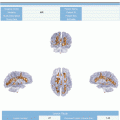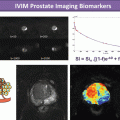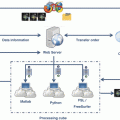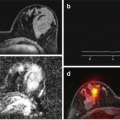The role in a clinical trial
Imaging biomarker type
How widely used
Comments
Determinate eligibility
Morphologic imaging (e.g., X-ray, mammography, CT, MRI)
Whole-body FDG-PET
Almost universal
Established biomarkers
Optimize patient population (patient stratification)
Molecular imaging (e.g., hypoxia imaging, metabolic imaging)
Emerging
Biomarkers have impact on patient management
Verify that the therapeutic target is present and accessible
Molecular imaging (e.g., drug-labeled radiotracer)
Commonly for certain targets
Biomarker used for proof of concept
Verify that the drug has the desired effect on the pathway and local physiology (e.g., define dose and schedule)
Molecular and functional imaging
Less often
Biomarker used for proof of concept
Evaluate efficacy
Conventional morphologic imaging
Almost universal
Established biomarkers
Molecular and functional imaging
Commonly for certain targets
Biomarker used for proof of concept
Evaluate safety
Morphologic and functional imaging
Very often
Established biomarkers
Drug approval (safety and efficacy)
Conventional morphologic imaging
Especially for accelerated approvals
Surrogate endpoint
The roles of imaging therefore change through the lifecycle of drug development and use and adapt to the objectives of the study, disease types, clinical situation, and feasibility. Some examples of using imaging biomarkers in the different stages of clinical trials are demonstrated in Table 21.2.
Table 21.2
Imaging biomarker at different stages of clinical trials
Phase | Objective | Scope | The role of imaging biomarkers | Examples of imaging biomarker used |
|---|---|---|---|---|
Phase 0 | First in human to test PK and PD | Single subtherapeutic doses of the study drug or treatment are given to a small number of subjects (10–15) to gather preliminary data on the agent’s PK and PD | Visualize whole-body drug bio-distribution and potentially provide insight into tumor characteristic in vivo | Radio-labeled tracers such as 89Zr-trastuzumab visualize their targets in the case of HER2 in breast cancer (NCT02065609) or 89Zr-bevacizumab in antiangiogenic treatment (NCT01894451) |
Phase 1 | Gathering evidence for the safety and appropriate dose of the drug in healthy volunteers or in patients | Testing within a small group of people (20–80) to evaluate safety, determine safe dosage ranges, and begin to identify side effects | Evaluate safety and optimize drug dose escalation | DCE-MRI used for antiangiogenic drug dose selection [26] (efficacy) LVEF used as a cardiac functional biomarker in tyrosine kinase inhibitor trials [49] (safety) |
Phase 2 | Gathering evidence for the safety and efficacy of the drug in patients | Testing with a larger group of people (100–200) to see if it is effective and to further evaluate its safety | Assess objective response and continue evaluate safety | MRI is commonly employed for safety monitoring in Alzheimer’s disease, especial in trials with investigational immunotherapy where vasogenic edema is a recognized risk [53] |
Phase 3 | Final confirmation of safety and efficacy to satisfy regulators | Testing with large groups of people (500–3000) to confirm its effectiveness, monitor side effects, and compare it to commonly used treatments | Confirm objective response or progression | Various criteria [54] based on imaging biomarkers obtained from tumor phenotype changes (e.g., size, density) or new lesion presence Cartilage thickness to evaluate response in knee osteoarthritis trials [55] |
Phase 4 | Sentry studies after marketing authorization | Post-marketing studies delineate additional information, including the treatment’s risks, benefits, and optimal use | Routine imaging to evaluate response, progression, or safety | Imaging modalities used for routine disease evaluation |
21.3.1 Determinate Eligibility
Eligibility criteria in clinical trials are designed to ensure the safety of research participants and tailored based on scientific objective of a trial. The eligibility criteria differ from trial to trial, but a clear diagnosis of disease characteristics and disease staging are often essential before patient enrollment. In oncology, the TNM staging system is widely used in trials in all solid tumors and remains a vital component of eligibility criteria. The TNM may be classified as an imaging biomarker, as it usually relies on imaging to define the size and extent of the primary tumor (T), any lymphatic involvement (N), and the presence of metastases (M). Whole-body PET imaging improves TNM assessment from morphologic imaging, as it reveals metastases not evident on conventional CT or MR imaging. Molecular imaging techniques are increasingly used to augment conventional imaging to confirm patient eligibility. For example, imaging with [18F]-FDG has been used in the EORTC LungTech trial, to ensure that enrolled patients are with inoperable early stage non-small cell lung cancer (NSCLC) [17].
21.3.2 Optimize Patient Population (Patient Stratification)
Clinical trials can be enriched by selecting subpopulations that may be more responsive to treatments, so as to improve the chance of trial success. Molecular and functional imaging provides additional information on tumor microenvironment, which could help to “preselect” sub-patient populations. For example, identification of tumor hypoxia could facilitate the use of hypoxia-stimulated pro-drugs, which selectively kill hypoxic cells. Tirapazamine, a cytotoxic agent with high selective toxicity toward hypoxic cells, is a good example. The relatively limited benefit obtained in a trial of NSCLC reported by the CATAPULT I study group was likely due to poor patient stratification with inclusion of patients with better-oxygenated tumors [18]. Rischin and his colleagues compared the cisplatin/5-FU versus cisplatin/tirapazamine regimen in patients with head and neck squamous-cell cancer (HNSCC), where [18F]-fluoromisonidazole (FMISO)-PET hypoxia imaging was used to stratify the tumors into hypoxic and non-hypoxic ones. The study showed that tirapazamine improved local tumor control in hypoxic but not in non-hypoxic tumors [19]. Similar examples are imaging with 99mTc-etarfolatide used to identify folate receptor-positive patients with advanced ovarian cancer, who are most likely to benefit from treatment with vintafolide, a folate receptor-targeted therapy [20], and [18F]-FDG used in patients with gefitinib-treated NSCLC, which showed a low baseline SUV of [18F]-FDG associated with a higher response rate (53 % versus 18 %) and a prolonged PFS (median, 33.1 weeks versus 8.6 weeks) [21]. The prognostic value of those imaging biomarkers needs to be further validated with multicentric prospective studies, to confirm that baseline imaging without any treatment effect can predict the degree of risk for disease occurrence, or progression and ultimately to implement this patient stratification strategy in therapeutic drug trails.
21.3.3 Verify That the Therapeutic Target Is Present and Accessible
A very direct approach in using imaging to verify therapeutic targets is to image the distribution of the drug itself. Typically, the drug molecule would be synthesized with a positron-emitting isotope (e.g., 11C or 18F) replacing the natural isotope, allowing detection by PET. This approach is common in neuroscience although rare in other diseases. Alternatively, for detection with single-photon emission computed tomography (SPECT), a gamma-emitting moiety may be attached to the drug molecule (albeit with the risk that the drug’s properties are thereby altered). An example is radiolabeled derivative of trastuzumab, an antihuman epidermal growth factor receptor 2 (HER2) monoclonal antibody used to treat breast cancer patients with HER2-expressing tumors [22, 23]. Radiolabeled trastuzumab helps to visualize the affinity of the drug in vivo and provides useful information about the PK properties of the drug, such as injected dose versus accumulated drug concentration in the organs and its regional bio-distribution. The noninvasive whole-body imaging overcomes problems associated with biopsies, including sampling errors and discordance of expression between primary tumors and metastases. More importantly, the drug uptake by the target tissue can be quantified at sequential imaging scans, and might provide insight into drug’s action at the target tissue and its association with tumor response. Indeed, for the radiotherapeutic drug [131I]-tositumomab, FDA requires that PK be verified by imaging before a therapeutic dose be given [24].
21.3.4 Verify That the Drug Has the Desired Effect on the Pathway and Local Physiology (e.g., Define Dose and Schedule)
Dose escalation and schedule, the main purpose of phase I trials, is usually undertaken to define the maximum tolerated dose (MTD), with the assumption that the most pronounced changes are likely to be detected at the highest dose. But, target saturation may already be reached at lower dose levels, and imaging changes are likely to be apparent and help to define an optimal biological dose. The effects of antiangiogenic therapies on dynamic contrast enhanced (DCE)-MRI have been documented in 39 phase I and II trials with a significant reduction in the transfer constant (K trans ) and/or initial area under the gadolinium curve (IAUGC) with multiple agents [25]. In a study of brivanib, a dual tyrosine kinase inhibitor of both vascular endothelial growth factor receptor and fibroblast growth factor receptor, DCE-MRI has been used in several dose schedules and then selected the optimal schedule for a phase II trial [26]. A similar approach has been used with vatalanib [27] and cediranib [28] in advanced cancer, and with sorafenib in renal cancer [29].
21.3.5 Evaluate Efficacy (Response Assessment)
Using imaging biomarkers as surrogate endpoint to assess new drug efficacy has been addressed in the above content. Clinical outcome such as mortality often takes years of follow-up to establish, and the determination of morbidity could be subjective. The use of imaging biomarkers to assess response or progression can reduce sample size, trial duration, and cost and accelerate the introduction of new drugs. A notable example is the approval of etanercept, a tumor necrosis factor inhibitor for the treatment of rheumatoid arthritis. A phase III trial [30] was designed to evaluate the efficacy and safety of etanercept and methotrexate (the standard of care) in patients with early rheumatoid arthritis, based on two sets of criteria: (1) the American College of Rheumatology scores, which used patient outcome report such as pain and function, in addition to serum C-reactive protein level and (2) imaging evidence of progression, such as joint-space narrowing and erosion. The clinical scoring only showed etanercept a more rapid treatment effect within the first 6 months but was approximately the same thereafter between two groups. Imaging-based erosion score showed significant differences of both immediate and long-term effect. The FDA granted etanercept a conditional marketing authorization. Subsequent studies demonstrated that etanercept achieved sustained improvement compared to methotrexate on both clinical and imaging scores [31]. A conditional approval is a continuum approach that drug developers should continue conducting studies to collect data on the effectiveness of drugs in use after initial approval and eventually provide evidence to keep the drug on the market and obtain a full approval within a predefined timeline.
21.3.6 Predict Response and Resistance (Early Assessment)
Many tyrosine kinase inhibitors and monoclonal antibodies targeting signal transduction inhibitor of tumor growth without tumor regression. Imatinib mesylate is such an example, a tyrosine kinase inhibitor for the treatment of chronic myelogenous leukemia and gastrointestinal stromal tumors (GIST). As opposed to the classical cytotoxic treatment, response rates are low, despite a high percentage of patients having prolonged stable disease and sometimes improvements in survival compared to standard therapies. Acute changes in tumor size are seldom significant in GIST patients treated by imatinib. However, when using [18F]-FDG-PET as a biomarker of tumor metabolism, response could be detected as early as 8 days following the start of treatment and was also associated with a longer PFS [32]. Other examples of early imaging assessment by MRI biomarkers have been reported [33, 34].
The use of functional and molecular imaging to predict the likelihood of response to a particular treatment at early stage is very attractive for drug development. This strategy has been used in early phase trials for proof of concept, although they still await validation to prove their relationships with clinical benefit. In these proof-of-concept trials, drug safety and efficacy will require the confirmation in subsequent trials.
21.3.7 Monitor Safety
Noninvasive imaging biomarkers have a huge potential in monitoring drug safety during clinical trials. In addition to LVEF and BMD, which have achieved surrogate endpoint status, emerging imaging biomarkers can detect drug-induced changes of vital organs and provide region-specific information about tissue abnormality, while serum and urine biomarkers can still be normal due to the functional reserve of the affected organs. The reserve of kidney function can compensate for up to 75 % of the loss, so serum and urine biomarkers are insensitive for early renal damage. A wide range of drugs can cause renal papillary necrosis, and the diagnosis tends to be made when irreversible destructive changes have occurred. Contrast-enhanced multiphasic CT can identify early signal changes of renal papillary necrosis and medullary necrosis and at the same time monitor lesion progression and regression. The liver is also a metabolic organ, often suffers from drug toxicity. In some cases, drug-induced hepatic steatosis can lead to a rapid evaluation of severe hepatic failure and ultimately death [35]. Both morphologic and functional liver imaging can display manifestations of hepatotoxicity, easier and earlier than histology techniques.
21.4 Pitfalls of Imaging Biomarker Implementation in Clinical Trials
Although many molecular and functional imaging biomarkers have been explored in clinical trials, few have yet proved adequate to support decision-making in drug development, in regulatory approval, or in clinical practice. Table 21.3 summarizes some common pitfalls of imaging biomarker implementation in trials, and each pitfall is accompanied by proposed solutions.
Table 21.3
Pitfalls of imaging biomarker implementation in clinical trials and proposed solutions
Pitfalls | Possible consequence | Proposed solutions |
|---|---|---|
Poor study methodology | ||
Insufficient or low-quality preclinical and early phase clinical data | Drug development is wrongly stopped, wrongly continued, or wrong dose/schedule selected | Follow guidelines before study initiation Critical development and review of guidelines by experts from different disciplines (clinicians and imagers) |
Inappropriate design selected (e.g., using an investigational imaging biomarker to assess an investigational therapeutic drug) | Unreliable data | Using well-established imaging biomarkers for patient eligibility or response assessment in new therapeutic drug trials Using well-known standard of care treatment as backbone studies to evaluate imaging biomarkers |
Inappropriate statistical consideration: low or inaccurate sample size calculation | Underpowered (false negative) or overpowered (unnecessary patient exposure, unnecessary cost) | Sample size calculation based on the objective of the trial and statistical plan should be written before data analysis |
Incorrect imaging acquisition or interpretation methods (e.g., miss the right detecting time window, inappropriate criteria used, data misinterpretation)
Stay updated, free articles. Join our Telegram channel
Full access? Get Clinical Tree
 Get Clinical Tree app for offline access
Get Clinical Tree app for offline access

| ||




